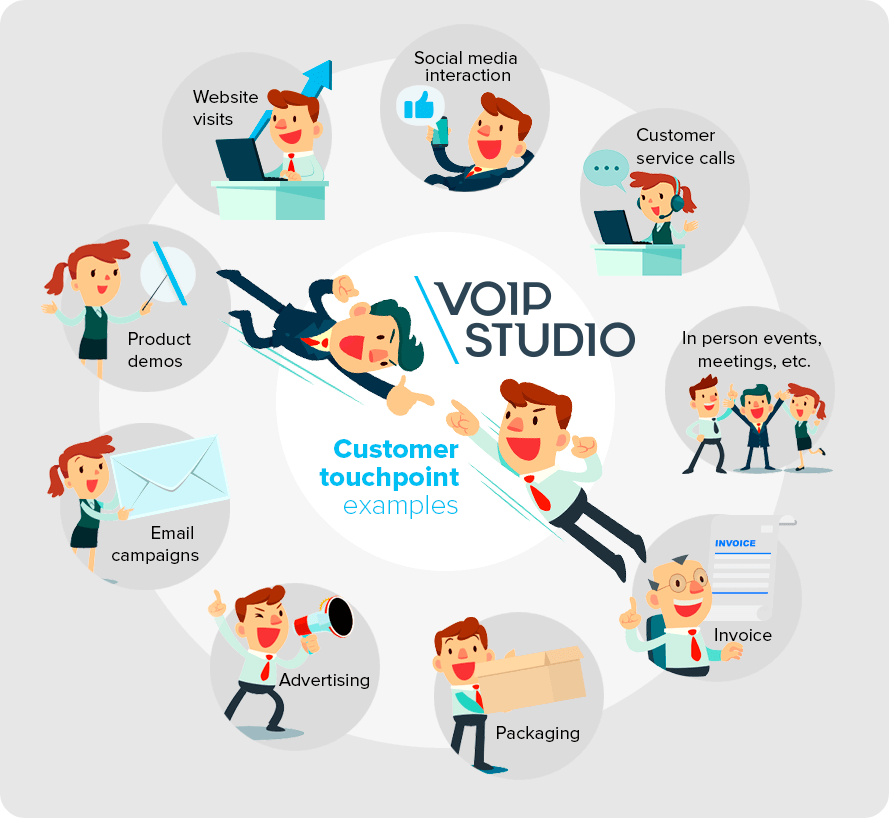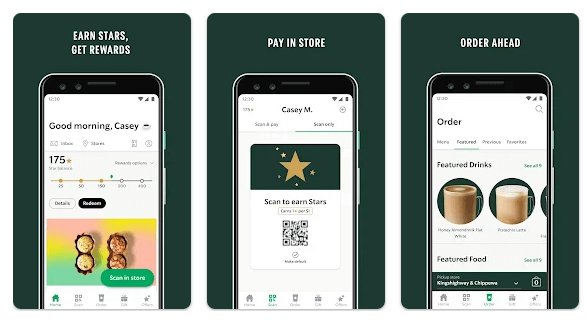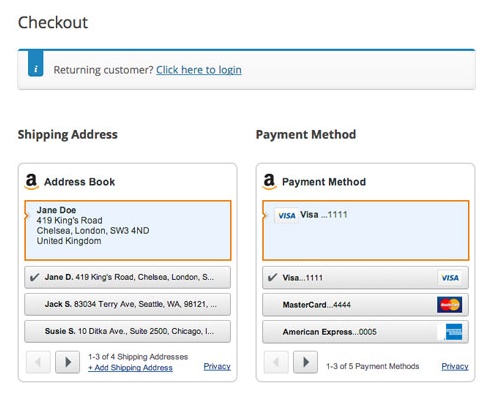
Table of contents
Why customer touchpoints matter for business success
In today’s competitive business landscape, customer experience is more important than ever. Consumers have higher expectations for the brands they interact with, and businesses must meet or exceed those expectations to succeed. One crucial aspect of delivering a great customer experience is through effective customer touchpoints.
Customer touchpoints are the points of contact between a customer and a business throughout the customer journey. They can include everything from marketing materials to customer service interactions and can happen both online and offline. Touchpoints can help companies to build strong customer relationships and drive business growth when managed effectively.
In this blog post, we’ll explore the importance of customer touchpoints and how they can impact customer success and business results. We’ll also discuss best practices for creating a winning touchpoint strategy and incorporating telephony, specifically VoIP Cloud Based telephony.
Defining customer touchpoints: what are they and why do they matter?
Customer touchpoints are the customer and business interaction points throughout the customer journey. They can include any customer interaction with a business, such as browsing a website, reading a marketing email, or speaking with customer service. Touchpoints can happen both online and offline and can take many different forms, including:
- Advertising and marketing materials.
- Website and social media content.
- Sales and customer service interactions.
- Billing and invoicing statements.
- Product packaging and displays.
Customer touchpoints matter for several reasons. First, they allow businesses to build customer relationships and create a positive customer experience. Each touchpoint is a chance to make a good impression and show the customer that their needs and preferences are valued. This can lead to increased customer loyalty and retention.
Second, touchpoints can significantly impact a customer’s perception of a brand. Negative touchpoints, such as a difficult customer service interaction or a confusing website experience, can lead to frustration and even cause a customer to switch to a competitor. On the other hand, positive touchpoints can reinforce a customer’s loyalty and encourage them to recommend the brand to others.
Finally, touchpoints can have a direct impact on business results. Businesses can increase customer satisfaction, improve customer retention, and drive revenue growth by optimizing touchpoints.
In the next section, we’ll explore how to map the customer journey and understand touchpoints in context.
Mapping the customer journey: understanding touchpoints in context
To create an effective touchpoint strategy, it’s essential to understand the customer journey and identify the most critical touchpoints for your customers. Customer journey mapping is a tool that can help you visualize the entire customer experience from start to finish and identify key touchpoints along the way.
The goal of mapping the customer journey and understanding touchpoints in context is to create a customer-centric touchpoint strategy focused on delivering a positive and seamless customer experience at every stage of the journey.
Let’s outline the steps to create an effective customer journey map.
Map the stages
To create a customer journey map, identify the stages a customer goes through when interacting with your business. This could include stages like awareness, consideration, purchase, and post-purchase.
Identify touchpoints
Next, consider the touchpoints at each stage, both online and offline. This could include, for example:
- Website visits.
- Product demos.
- Email campaigns.
- Social media interactions.
- Customer service calls.
To understand touchpoints in context, it’s important to consider the customer’s mindset and goals at each journey stage. For example, a customer in the awareness stage may be seeking information about a particular product or service, while a customer in the post-purchase stage may be looking for support or resources to help them get the most out of their purchase.
Prioritize
Once you have identified the touchpoints, it’s important to prioritize them based on their impact on the customer experience and business results. By understanding the context in which touchpoints occur, you can prioritize them accordingly. Which touchpoints are most important for creating a positive customer experience? Which touchpoints are most likely to drive customer satisfaction and retention? Which touchpoints are most likely to lead to sales or revenue growth?
Define the strategy
By answering these questions, you can develop a touchpoint strategy focused on the most important interactions with your customers. This strategy could include optimizing your website and social media content, improving your customer service processes, or investing in marketing campaigns that target specific touchpoints in the customer journey.
How touchpoints impact customer success: examples and case studies
Customer touchpoints can significantly impact customer success, which in turn can affect business results. By providing positive touchpoints throughout the customer journey, businesses can improve customer satisfaction, increase customer loyalty, and ultimately drive revenue growth.
Here are a few examples of how touchpoints can impact customer success:
- A customer with a positive experience with a sales representative is more likely to make a purchase and become a loyal customer.
- Customers receiving prompt and effective customer service are more likely to continue using a product or service.
- A customer with a positive experience with a brand on social media is more likely to recommend that brand to others.
To illustrate these points, let’s look at a few case studies:
Starbucks
Starbucks has a mobile app that allows customers to order and pay for drinks ahead of time, reducing wait times and improving the overall customer experience. By providing this touchpoint, Starbucks has increased customer satisfaction and loyalty, leading to increased revenue growth.
Hilton Worldwide
Hilton Worldwide is a global hospitality company with an extensive network of hotels and resorts. One of the ways that Hilton has been able to build strong relationships with its customers is by providing a high-quality phone support experience. Hilton’s call center agents are trained to handle a wide range of customer inquiries and issues. They are empowered to make decisions that will help resolve customer problems quickly and effectively.
Amazon
Amazon has a user-friendly website and streamlined checkout process, making it easy for customers to find and purchase products. By providing a positive online shopping experience, Amazon has become one of the most successful e-commerce companies in the world.
Delta Air Lines
Delta Air Lines is one of the largest airlines in the world, and they are known for providing a high-quality customer experience. One of the ways that Delta has been able to achieve this is by providing a comprehensive customer support system that includes phone support, email support, and social media support. Delta’s call center agents can effectively deal with all kinds of customer inquiries and issues and provide support in multiple languages.
Best practices for creating a winning touchpoint strategy
Creating a winning touchpoint strategy involves some key steps, including:
Identifying and prioritizing key touchpoints
The first step in creating a winning touchpoint strategy is identifying and prioritizing the key touchpoints that matter most to your customers. These touchpoints could include everything from your website and mobile app to your call center and in-store experience.
Crafting compelling customer experiences
Once you have identified your key touchpoints, the next step is to craft compelling customer experiences that will delight your customers and differentiate your brand. This step could involve everything from improving the design and usability of your website and mobile app to providing personalized and relevant content and offers to your customers.
Leveraging technology and data for optimization
Finally, it’s important to leverage technology and data for optimization to create a winning touchpoint strategy. Use data analytics and customer feedback to identify areas for improvement. Implement new technologies like chatbots and AI to enhance the customer experience and leverage cloud-based telephony or VoIP solutions to improve call center efficiency and effectiveness.
B2B customer journey touchpoints: challenges and opportunities
Business-to-business (B2B) customer journeys can be more complex than individual customers. This is because B2B customers often have longer and more convoluted sales cycles, with multiple decision-makers involved in the purchasing process. Understanding the unique needs and behaviors of B2B customers is essential to mapping their touchpoints accurately.
Mapping the touchpoints of complex B2B sales cycles is a challenge but a critical component of a successful touchpoint strategy. The challenge lies in identifying and tracking the various touchpoints throughout the sales cycle, which may involve multiple channels and touchpoints over an extended period.
To maximize the effectiveness of B2B touchpoints, it is essential to design targeted, personalized experiences that cater to the specific needs and preferences of each decision-maker involved in the purchasing process. Use a combination of touchpoints, including phone calls, email campaigns, webinars, and in-person meetings, to provide a seamless and engaging experience that helps to move the customer towards a purchase decision.
Incorporating telephony into your touchpoint strategy
Telephony remains a crucial component of any touchpoint strategy today. With the advent of VoIP and cloud-based telephony, companies can leverage these technologies to enhance customer engagement and satisfaction.
The benefits of VoIP and cloud-based telephony for business communications are numerous. Firstly, they allow for greater flexibility and scalability, making it easier for businesses to adapt to changing customer needs. Additionally, they often offer advanced features such as call recording and transcription, which can help companies better understand customer needs and preferences.
When maximizing customer engagement and satisfaction through voice touchpoints, there are a few key strategies to remember. First, it’s essential to ensure that your phone system is easy to use and provides a seamless experience for customers. Take care of things like minimizing hold times, providing clear and concise instructions, and routing calls to the right department or agent.
Another key strategy is to leverage data and analytics to gain insights into customer behavior and preferences. For example, you can analyze call recordings and transcripts to identify common pain points or areas for improvement. You can also use data to personalize the customer experience, such as by using customer data to route calls to the right agent or by offering targeted promotions or discounts.
Measuring and optimizing touchpoint performance: key metrics and tools
Once you have identified and prioritized your key touchpoints and crafted compelling experiences, it is vital to measure and optimize their performance. This continuous improvement process involves tracking key metrics and using various tools to analyze customer behavior and feedback.
Some key metrics to consider when measuring touchpoint performance include:
- Customer Satisfaction: Measuring customer satisfaction at each touchpoint can help you identify areas where improvements are needed.
- Net Promoter Score (NPS): This metric measures customer loyalty and willingness to recommend your business to others. Tracking NPS at different touchpoints can help you identify which ones are driving customer loyalty.
- Customer Effort Score (CES): This metric measures how easily customers can complete their desired actions at each touchpoint. A high CES score indicates a positive customer experience.
- Conversion Rate: Measuring conversion rates at each touchpoint can help you identify the most effective at driving sales or other desired actions.
Various tools and technologies are available to help you measure and optimize touchpoint performance, including customer feedback surveys, web analytics tools, and CRM systems.
More from the blog
Want to improve your business communication?
Unlock enterprise-class call center power at affordable prices – no hardware, no delays, no surprises!










